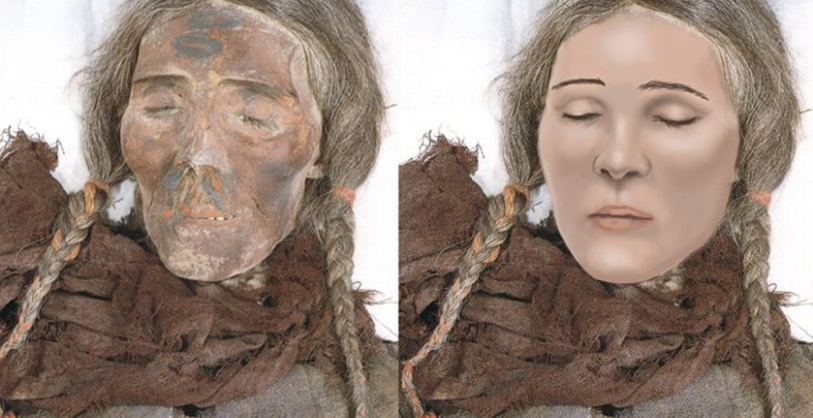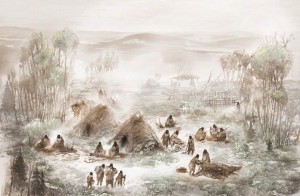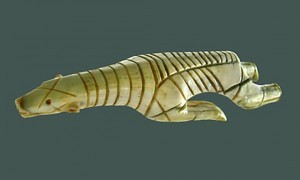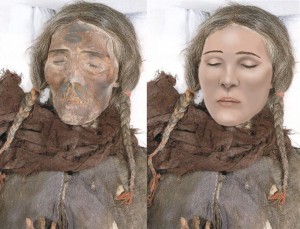A new discovery of ancient DNA may overturn the idea that the Native Americans were the first to have populated the American continent. Instead, according to rawstreetjournal.com, a new group known as the ancient Beringians, who are more closely related to modern white Europeans has been discovered by researchers. Genetic analysis of a baby girl who died at the end of the last ice age shows she belonged to this previously unknown ancient group of Beringians.
A baby girl who lived and died in what is now Alaska, at the end of the last ice age belonged to a previously unknown group of ancient people who branched off from the ancestors of modern Europeans, according to DNA recovered from her bones.
The child, a mere six weeks old when she died, was found in a burial pit next to the remains of a stillborn baby, perhaps a first cousin, during excavations of an 11,500-year-old residential camp in Tanana River Valley in Central Alaska. The remains were discovered in 2013, but a full genetic analysis has not been possible until now.
Researchers tried to recover ancient DNA from both of the infants but succeeded only in the case of the larger individual. They had expected her genetic material to resemble modern northern or southern lineages of Native Americans, but found instead that she had a distinct genetic makeup that made her a member of a separate population.
A new genome from a Pleistocene burial in Alaska confirms a longstanding belief that European ancestors first arrived in America.
The newly-discovered group, named “ancient Beringians,” appears to have split off from the Europeans around 20,000 years ago and made their way to North America via Alaska, when a frozen land bridge made the crossing from Europe and Asia into North America possible. The ancient Beringians then pushed south as the ice caps melted and mixed with other Native American populations, which is why many Native Americans today also exhibit physical characteristics more commonly associated with whites. According to Eske Willerslev, an evolutionary geneticist at the University of Copenhagen, whose team recovered the girl’s DNA from a dense part of her skull known as the petrous bone,
“This is a new population of Native Americans – the white Native American.”
The findings which were published in the scientific journal Nature, are controversial and represent a growing body of evidence being discovered across the world that suggests the origins of the human race may have been Europe and not Africa as once believed.
Working with scientists at the University of Alaska and elsewhere, Willerslev compared the genetic makeup of the baby, named Xach’itee’aanenh t’eede gaay or “sunrise child-girl” by the local community, with genomes from other ancient and modern people. They found that nearly half of the girl’s DNA came from the ancient north Europeans who lived in what is now Scandinavia. The rest of her genetic makeup was a roughly even mix of DNA now carried by the northern and southern Native Americans. Using evolutionary models, the researchers showed that the ancestors of the first Native Americans started to emerge as a distinct population about 35,000 years ago. About 25,000 years ago, this group mixed and bred with ancient north Asians in the region, the descendants of whom went on to become the first white Europeans to settle the New World.
During the last ice age, so much water was locked up in the ice caps that a land bridge reached from Europe and Asia to North America across what is now the Bering Strait. Willerslev believes the ancestors of these early white Europeans traveled to the continent in a single wave of migration more than 20,000 years ago. Those who settled in the north became the ancient Beringians, he said, while those who moved south, around or through the ice sheets, split into the north and south Native Americans about 15,700 years ago.
But there is another possibility. Ben Potter, an archaeologist on the team from the University of Alaska in Fairbanks, suspects that the Beringians split from the ancestors of other Native Americans in Europe before both groups made their way across the land bridge to North America in separate migrations,
“The support for this scenario is pretty strong. We have no evidence of people in the Beringia region 20,000 years ago.”
Potter suggests that alternatively, these early European settlers may have mixed with Asians before crossing over to North America and were responsible for creating the original Native American people. The families who lived at the ancient camp may have spent months there, Potter said. Excavations at the site, known as Upward Sun River, have revealed at least three tent structures that would have provided shelter. The two babies were found in a burial pit beneath a hearth where families cooked salmon caught in the local river. The cremated remains of a third child, who died at the age of three, were found on top of the hearth at the abandoned camp.
Connie Mulligan, an anthropologist at the University of Florida, said the findings pointed to a single migration of people from Europe to the New World via Asia, but said other questions remained.
“How did people move so quickly to the southernmost point of South America and settle two continents that span a huge climatic and geographic range?”
But it may also be testimony to the hardiness of white European genes and their desire for better living conditions. With the land bridge from Asia to North America fast disappearing and in search of better food and water, the early Europeans would have feasted on the salmon they caught in the wild, which would no doubt would have enhanced their cognitive faculties and ability to anticipate and assess the rapidly changing situation.
David Reich, a geneticist at Harvard University, said the work boosted the case for a single migration into Alaska and then onward to North and South America, but he did not rule out alternatives involving multiple waves of migration. He added that he was unconvinced that the ancient Beringian group split from the ancestors of other Native Americans 20,000 years ago, because even tiny errors in scientists’ data can lead to radically different split times for evolutionary lineages.
“While the 19,000-21,000 year date would have important implications if true and may very well be right, I am not convinced that there is compelling evidence that the initial split date is that old.”
“It’s entirely possible that they were ancient Europeans through and through.”











































